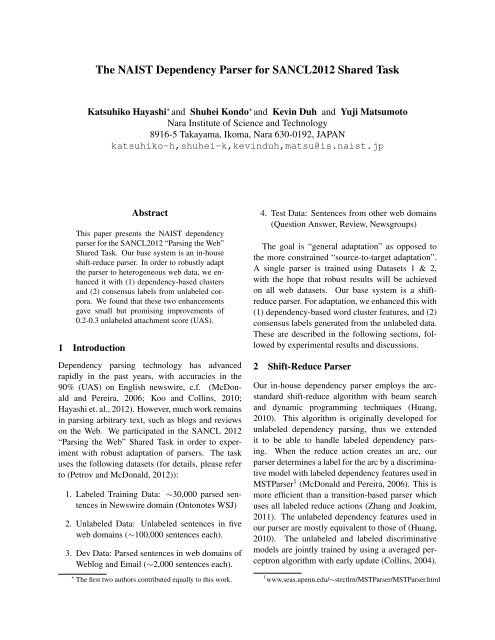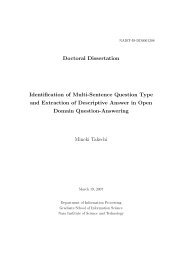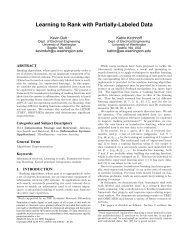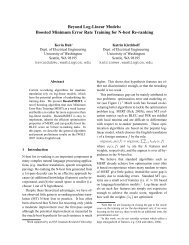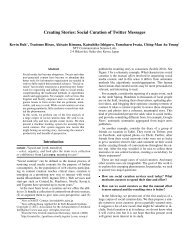The NAIST Dependency Parser for SANCL2012 Shared Task
The NAIST Dependency Parser for SANCL2012 Shared Task
The NAIST Dependency Parser for SANCL2012 Shared Task
You also want an ePaper? Increase the reach of your titles
YUMPU automatically turns print PDFs into web optimized ePapers that Google loves.
<strong>The</strong> <strong>NAIST</strong> <strong>Dependency</strong> <strong>Parser</strong> <strong>for</strong> <strong>SANCL2012</strong> <strong>Shared</strong> <strong>Task</strong><br />
Katsuhiko Hayashi ∗ and Shuhei Kondo ∗ and Kevin Duh and Yuji Matsumoto<br />
Nara Institute of Science and Technology<br />
8916-5 Takayama, Ikoma, Nara 630-0192, JAPAN<br />
katsuhiko-h,shuhei-k,kevinduh,matsu@is.naist.jp<br />
Abstract<br />
This paper presents the <strong>NAIST</strong> dependency<br />
parser <strong>for</strong> the <strong>SANCL2012</strong> “Parsing the Web”<br />
<strong>Shared</strong> <strong>Task</strong>. Our base system is an in-house<br />
shift-reduce parser. In order to robustly adapt<br />
the parser to heterogeneous web data, we enhanced<br />
it with (1) dependency-based clusters<br />
and (2) consensus labels from unlabeled corpora.<br />
We found that these two enhancements<br />
gave small but promising improvements of<br />
0.2-0.3 unlabeled attachment score (UAS).<br />
1 Introduction<br />
<strong>Dependency</strong> parsing technology has advanced<br />
rapidly in the past years, with accuracies in the<br />
90% (UAS) on English newswire, c.f. (McDonald<br />
and Pereira, 2006; Koo and Collins, 2010;<br />
Hayashi et. al., 2012). However, much work remains<br />
in parsing arbitrary text, such as blogs and reviews<br />
on the Web. We participated in the SANCL 2012<br />
“Parsing the Web” <strong>Shared</strong> <strong>Task</strong> in order to experiment<br />
with robust adaptation of parsers. <strong>The</strong> task<br />
uses the following datasets (<strong>for</strong> details, please refer<br />
to (Petrov and McDonald, 2012)):<br />
1. Labeled Training Data: ∼30,000 parsed sentences<br />
in Newswire domain (Ontonotes WSJ)<br />
2. Unlabeled Data: Unlabeled sentences in five<br />
web domains (∼100,000 sentences each).<br />
3. Dev Data: Parsed sentences in web domains of<br />
Weblog and Email (∼2,000 sentences each).<br />
∗ <strong>The</strong> first two authors contributed equally to this work.<br />
4. Test Data: Sentences from other web domains<br />
(Question Answer, Review, Newsgroups)<br />
<strong>The</strong> goal is “general adaptation” as opposed to<br />
the more constrained “source-to-target adaptation”.<br />
A single parser is trained using Datasets 1 & 2,<br />
with the hope that robust results will be achieved<br />
on all web datasets. Our base system is a shiftreduce<br />
parser. For adaptation, we enhanced this with<br />
(1) dependency-based word cluster features, and (2)<br />
consensus labels generated from the unlabeled data.<br />
<strong>The</strong>se are described in the following sections, followed<br />
by experimental results and discussions.<br />
2 Shift-Reduce <strong>Parser</strong><br />
Our in-house dependency parser employs the arcstandard<br />
shift-reduce algorithm with beam search<br />
and dynamic programming techniques (Huang,<br />
2010). This algorithm is originally developed <strong>for</strong><br />
unlabeled dependency parsing, thus we extended<br />
it to be able to handle labeled dependency parsing.<br />
When the reduce action creates an arc, our<br />
parser determines a label <strong>for</strong> the arc by a discriminative<br />
model with labeled dependency features used in<br />
MST<strong>Parser</strong> 1 (McDonald and Pereira, 2006). This is<br />
more efficient than a transition-based parser which<br />
uses all labeled reduce actions (Zhang and Joakim,<br />
2011). <strong>The</strong> unlabeled dependency features used in<br />
our parser are mostly equivalent to those of (Huang,<br />
2010). <strong>The</strong> unlabeled and labeled discriminative<br />
models are jointly trained by using a averaged perceptron<br />
algorithm with early update (Collins, 2004).<br />
1 www.seas.upenn.edu/∼strctlrn/MST<strong>Parser</strong>/MST<strong>Parser</strong>.html
Our parser uses POS tags provided by the<br />
Stan<strong>for</strong>d POS tagger (Toutanova et. al., 2003).<br />
<strong>The</strong> model is trained on the provided labeled<br />
training data, with the following training options:<br />
bidirectional5words, naacl2003unknowns and<br />
wordshapes(-1,1). <strong>The</strong> number of iterations was 10.<br />
We used only the Penn Tagset and did not experiment<br />
with the Universal POS-set provided with the<br />
training data (due to time constraints).<br />
3 Extensions <strong>for</strong> Domain Adaptation<br />
<strong>The</strong>oretically, we can view the domain adaptation<br />
problem as a change in the distribution p(x, y) =<br />
p(y|x)p(x), where p(x) is the input distribution of<br />
sentences and p(y|x) is the conditional distribution<br />
of parse y given sentence x (Jiang and Zhai, 2007).<br />
Either p(x) or p(y|x) may vary as we move across<br />
domains, and mismatch in either (with respect to the<br />
training data) leads to per<strong>for</strong>mance degradation. Our<br />
dependency-based cluster tackles mismatch in p(x)<br />
by tying together word features, while our consensus<br />
label approach attempts to reduce p(y|x) mismatch<br />
by re-training on auto-parses of web data.<br />
3.1 <strong>Dependency</strong>-based Cluster Features<br />
Word clusters have been shown to give good per<strong>for</strong>mance<br />
<strong>for</strong> dependency parsing, especially in the<br />
context of semi-supervised parsing (Koo et. al.,<br />
2008). Here we follow Koo’s approach in incorporating<br />
word clusters as additional features into the<br />
parser. However, rather than cluster using word n-<br />
gram in<strong>for</strong>mation, we cluster using dependency n-<br />
gram in<strong>for</strong>mation. <strong>The</strong> motivation is that head/child<br />
in<strong>for</strong>mation may provide more useful generalizations<br />
than neighboring left/right context (Sagae and<br />
Gordon, 2009; Haffari et. al., 2011). In particular,<br />
we first parse the unlabeled data with the MST<br />
<strong>Parser</strong>, then extract head-child in<strong>for</strong>mation as bigram<br />
dependencies. This is given to the Brown clustering<br />
algorithm 2 , generating 32 cluster features <strong>for</strong><br />
the shift-reduce parser.<br />
3.2 Consensus Labels from Unlabeled Data<br />
Self-training and co-training can be effective methods<br />
<strong>for</strong> domain adaptation (McClosky et. al., 2008).<br />
Here we experimented with a co-training scheme<br />
2 cs.stan<strong>for</strong>d.edu/∼pliang/software/brown-cluster-1.2.zip<br />
where consensus parses provided by the MST parser<br />
and Berkeley parser 3 are given to our shift-reduce<br />
parser. Specifically, we parsed the unlabeled training<br />
data with the MST parser and the Berkeley<br />
parser, both trained on the labeled training data.<br />
<strong>The</strong>n we converted the outputs of the Berkeley<br />
parser into dependency trees and extracted trees on<br />
which the two parsers reached a (exact-match) consensus<br />
in terms of the unlabeled arc structure. As<br />
a result 5,200 trees were extracted, and we added<br />
them to the training data <strong>for</strong> the submitted system.<br />
For POS tags and the edge labels, we used the outputs<br />
of the Stan<strong>for</strong>d POS tagger and the MST parser.<br />
4 Preliminary Experiments and Discussion<br />
Tables 1 and 2 show the UAS and LAS on the<br />
Dev data, using either true (goldtag) or predicted<br />
(autotag) POS tags. <strong>The</strong> baseline system is our<br />
shift-reduce parser trained on the labeled newswire<br />
training data (dataset 1), without any extensions<br />
<strong>for</strong> adaptation. <strong>The</strong> +ngramcluster is the baseline<br />
system enhanced with ngram-based clusters like<br />
(Koo et. al., 2008), while +depcluster is the one<br />
enhanced with dependency-based clusters. Systems<br />
using additional consensus labels are indicated<br />
by +consensus. Our official submission is baseline+consensus+depclusters,<br />
which is the best of<br />
the bunch in general and observes a slight improvement<br />
of 0.2 UAS in EMAIL (autotag) and of 0.3<br />
UAS in WEBLOG (autotag) over baseline. <strong>The</strong> test<br />
results are shown in Table 3.<br />
Due to time constraints 4 , we did not attempt many<br />
important experimental variations. Although the<br />
slight improvements are promising, we think the following<br />
future work are worth investigating in detail:<br />
• Word clustering with combined n-gram and<br />
syntax in<strong>for</strong>mation, since it is likely a single<br />
view is ineffective in clustering rare words.<br />
• Consensus labels derived from partial parse<br />
matches, since exact match is too strict and<br />
generates too few additional labels.<br />
• Analysis and quantification of p(x) and p(y|x)<br />
mismatches in web data. Which one is more<br />
serious and deserves more research?<br />
3 http://code.google.com/p/berkeleyparser/<br />
4 We had a late start in participating in this shared task.
EMAIL WEBLOGS<br />
SYSTEM goldtag autotag goldtag autotag<br />
baseline 83.4 78.0 89.0 85.6<br />
+ngramclusters 83.5 78.0 88.6 85.6<br />
+depclusters 83.4 78.2 88.7 85.6<br />
+consensus 83.1 78.1 88.6 85.5<br />
+consensus+ngramclusters 83.7 78.0 88.8 85.5<br />
+consensus+depclusters 83.6 78.2 89.1 85.9<br />
Table 1: Unlabeled Attachment Score (UAS) on Dev data<br />
EMAIL WEBLOGS<br />
SYSTEM goldtag autotag goldtag autotag<br />
baseline 80.3 73.1 86.3 81.5<br />
+ngramclusters 80.2 73.0 86.0 81.6<br />
+depclusters 80.1 73.2 86.1 81.6<br />
+consensus 79.9 73.2 86.1 81.5<br />
+consensus+ngramclusters 80.7 72.9 86.2 81.5<br />
+consensus+depclusters 80.4 73.2 86.4 81.7<br />
Table 2: Labeled Attachment Score (LAS) on Dev data<br />
ANSWERS (A) NEWSGROUP (B) REVIEWS (C) AVG (A-C) WSJ (D)<br />
LAS 73.54 79.83 75.72 76.36 87.95<br />
UAS 79.89 84.59 81.99 82.16 90.99<br />
POS 89.92 91.39 90.47 90.59 97.40<br />
Table 3: Test Results (baseline+consensus+depclusters)
References<br />
Michael Collins and Brian Roark. 2004. Incremental<br />
Parsing with the Perceptron Algorithm. Proceedings<br />
of the 42nd Meeting of the Association <strong>for</strong> Computational<br />
Linguistics (ACL’04), Main Volume, pg. 111–<br />
118<br />
Katsuhiko Hayashi and Taro Watanabe and Masayuki<br />
Asahara and Yuji Matsumoto. 2012. Head-driven<br />
Transition-based Parsing with Top-down Prediction.<br />
Proceedings of the Association <strong>for</strong> Computational Linguistics<br />
(ACL).<br />
Liang Huang and Kenji Sagae. 2010. Dynamic Programming<br />
<strong>for</strong> Linear-Time Incremental Parsing. Proceedings<br />
of the 48th Annual Meeting of the Association <strong>for</strong><br />
Computational Linguistics, pg. 1077–1086,<br />
Terry Koo and Michael Collins. 2010. Efficient Thirdorder<br />
<strong>Dependency</strong> <strong>Parser</strong>s Proceedings of the Association<br />
<strong>for</strong> Computational Linguistics (ACL).<br />
Terry Koo and Xavier Carreras and Michael Collins.<br />
2008. Simple Semi-supervised <strong>Dependency</strong> Parsing<br />
Proceedings of the Association <strong>for</strong> Computational Linguistics<br />
(ACL).<br />
Jing Jiang and ChengXiang Zhai. 2007. Instance weighting<br />
<strong>for</strong> domain adaptation in NLP. Proc. of the Association<br />
<strong>for</strong> Computational Linguistics (ACL).<br />
Gholamreza Haffari and Marzieh Razavi and Anoop<br />
Sarkar. 2011 An Ensemble Model that Combines<br />
Syntactic and Semantic Clustering <strong>for</strong> Discriminative<br />
<strong>Dependency</strong> Parsing. Proceedings of the 49th Annual<br />
Meeting of the Association <strong>for</strong> Computational Linguistics:<br />
Human Language Technologies.<br />
David McClosky and Eugene Charniak and Mark Johnson.<br />
When is Self-Training Effective <strong>for</strong> Parsing?<br />
Proceedings of the International Conference on Computational<br />
Linguistics (COLING 2008)<br />
Ryan McDonald and Fernando Pereira. 2006. Online<br />
Learning of Approximate <strong>Dependency</strong> Parsing Algorithms.<br />
Proceedings of the 11th EACL.<br />
Slav Petrov and Ryan McDonald. 2012. Overview of<br />
the 2012 <strong>Shared</strong> <strong>Task</strong> on Parsing the Web Notes<br />
of the First Workshop on Syntactic Analysis of Non-<br />
Canonical Language (SANCL).<br />
Kenji Sagae and Andrew Gordon. 2009 Clustering<br />
Words by Syntactic Similarity Improves <strong>Dependency</strong><br />
Parsing of Predicate-Argument Structures. Proceedings<br />
of the 11th International Conference on Parsing<br />
Technologies (IWPT)<br />
Kristina Toutanova and Dan Klein and Christopher Manning<br />
and Yoram Singer. 2003. Feature-Rich Part-of-<br />
Speech Tagging with a Cyclic <strong>Dependency</strong> Network.<br />
Proceedings of HLT-NAACL 2003, pp. 252-259.<br />
Yue Zhang and Joakim Nivre. 2011. Transition-based<br />
<strong>Dependency</strong> Parsing with Rich Non-local Features.<br />
Proceedings of the 49th Annual Meeting of the Association<br />
<strong>for</strong> Computational Linguistics: Human Language<br />
Technologies, pg. 188–193


